Welcome to Roger Russell's
McIntosh Equalizer History Part 3
The MQ104 Equalizer, AA2 Analyzer
and CM201 Microphone
This
page is copyrighted
No portion of this site may be reproduced in whole or in part
without written permission of the author.
![]()
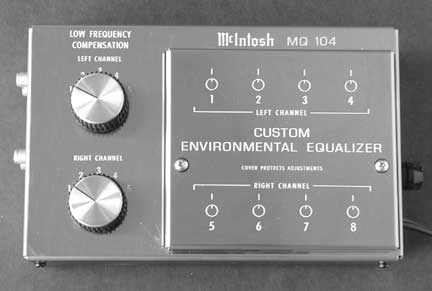 The MQ104 Custom Environmental Equalizer provides the
same basic low frequency compensation controls as the MQ101 and MQ102. The
individual controls can be seen at the left portion of the MQ104. These 5
positions not only provide correct compensation for the overdamped woofer but
also correct for the solid angle where the woofer radiates into the room. The
response at the speaker is then flat right down to 20Hz. This compensation is
required for all of the ML systems plus the XR3, XR5, XR6, XR7 and XR14
systems. However, this compensation does not correct for room resonances.
The MQ104 Custom Environmental Equalizer provides the
same basic low frequency compensation controls as the MQ101 and MQ102. The
individual controls can be seen at the left portion of the MQ104. These 5
positions not only provide correct compensation for the overdamped woofer but
also correct for the solid angle where the woofer radiates into the room. The
response at the speaker is then flat right down to 20Hz. This compensation is
required for all of the ML systems plus the XR3, XR5, XR6, XR7 and XR14
systems. However, this compensation does not correct for room resonances.
The MQ104 goes a step further. It has four adjustable filters in each channel. These filters can be tuned to greatly reduce the effect of room resonances from 20Hz up to 1kHz. The response can be adjusted to have lower output at frequencies where there is a corresponding acoustic peak and increased output at frequencies where there is a dip. The resulting acoustic response at the listening position is then smoothed out. Low frequency compensation can be used along with the filters to achieve this.
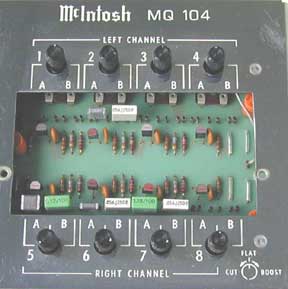 The filters are programmable to be 1/3 octave or 1
octave wide. They and can each boost or cut 12dB in the narrow mode or 15dB in
the wide mode. The picture at the right shows the top cover removed. The center
frequencies and filter width can be programmed by plugging in two capacitors
for each filter. A Frequency Programming Table
(shown further down on this page) is provided to select 1/3 octave or octave
center frequencies from 20Hz to 1kHz. From the table, the required capacitor
values for A and B can be found.
The filters are programmable to be 1/3 octave or 1
octave wide. They and can each boost or cut 12dB in the narrow mode or 15dB in
the wide mode. The picture at the right shows the top cover removed. The center
frequencies and filter width can be programmed by plugging in two capacitors
for each filter. A Frequency Programming Table
(shown further down on this page) is provided to select 1/3 octave or octave
center frequencies from 20Hz to 1kHz. From the table, the required capacitor
values for A and B can be found.
A compartment box with capacitors is provided with each MQ104. Each filter has a control with a center detent that can be adjusted for the amplitude of the boost or cut. The center position is electrically flat. Three holes are available for each capacitor. Only two holes are actually used depending on the lead spacing of the capacitors. Several record sheets are provided that fit under the top cover. The frequencies and capacitor values can be recorded there for each filter.
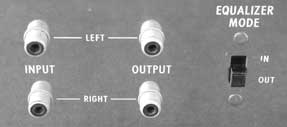 As in the earlier equalizers, the MQ104 is inserted
between the preamplifier and power amplifier. A switch is on the side of the
MQ104 so that the filter section can be switched in or out for comparison
purposes. After the response is adjusted, the cover can be fastened in place
and the unit put out of the way behind other equipment.
As in the earlier equalizers, the MQ104 is inserted
between the preamplifier and power amplifier. A switch is on the side of the
MQ104 so that the filter section can be switched in or out for comparison
purposes. After the response is adjusted, the cover can be fastened in place
and the unit put out of the way behind other equipment.
Later McIntosh systems that no longer use overdamped woofers, and do not require the low frequency compensation, can still be taken a step further with the MQ104. The MQ104 can also be used with other brands of systems as well, but the low frequency compensation switches should be set at the electrically flat position 1. Low frequency compensation is not recommended for other brands of systems because the bass boost may overdrive other woofers that are not designed for this kind of use. Also, when using other brands of woofers with the MQ104 filters in the boost mode, it means that the speaker will be driven with more power in that frequency band or bands. This is not a problem for the McIntosh speakers that are designed to handle high power.
The exception for all systems is the vented type of design. At 20Hz, and perhaps higher frequencies, the port or passive radiator is usually completely out of phase with the driving cone resulting in complete cancellation. No amount of boost can compensate for these conditions. There is also the possibility of overdriving an amplifier that does not have Power Guard. If the MQ104 is used with another brand of loudspeaker and/or an amplifier that doesn't have Power Guard, the boost mode is to be used sparingly or not at all.
Although the procedure for adjusting the filters is relatively simple, the MQ104 CANNOT be utilized to its fullest potential by using music or other program material as a test signal. Measurement is absolutely necessary to establish the exact frequencies and amplitudes that are a problem so the MQ104 can be correctly tuned. A 1/3 octave analyzer is needed. The tape monitor feature used in the MQ101 and MQ102 is not used in the MQ104 or later equalizers.
Specifications
Frequency Response: 20Hz to 20,000Hz with equalization set flat.
Hum and Noise: 90 dB (79uV) below rated output of 2.5V. Worst case
setting, 85 dB (140uV) below rated output of 2.5V.
Harmonic and IM Distortion: less than 0.1% at rated output of 2.5V from 20 to
20,000Hz
Low Frequency Compensation: 5 steps are included for early McIntosh speakers,
allowing 0 to +17 at 20Hz.
Input Sensitivity and Impedance: 2.5 volts into 27,000 ohms for rated output with
controls set for flat response.
Output level and Impedance: 2.5 volts into 27,000 ohms or more with controls set
for flat response. Output source impedance is 600 ohms.
Programmable Filters: 8 sections (4 per channel) each of which can be
programmed for 1/3 octave center frequencies from 20Hz to 1000Hz. Filter
bandwidth is programmable for narrow (approx.1/3 octave) or wide (approx. 1
octave). Amplitude is continuously adjustable +/- 12 dB for narrow and +/- 15
dB for wide. A dented control is used to position for flat response.
Programming is achieved by means of plug-in capacitors provided with the MQ104.
Chassis: Chrome and Black
Weight: 4-3/4 lbs. (2.15 kg) net, 6-1/4 lbs. (2.83 kg) in
shipping carton.
![]()
MQ104 and MQ107 Frequency Programming Table
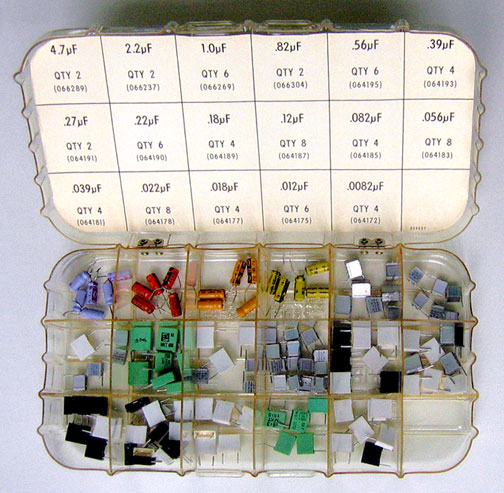
All capacitor values are shown in microfarads
|
|
Narrow Filter |
Wide Filter |
||
|
Frequency |
Capacitor A |
Capacitor B |
Capacitor A |
Capacitor B |
|
20 |
1.0 |
.39 |
-- |
-- |
|
25 |
1.0 |
.27 |
4.7 |
.056 |
|
31.5 |
.82 |
.22 |
-- |
-- |
|
40 |
.56 |
.18 |
-- |
-- |
|
50 |
.56 |
.12 |
2.2 |
.022 |
|
63 |
.39 |
.12 |
-- |
-- |
|
80 |
.22 |
.12 |
-- |
-- |
|
100 |
.22 |
.082 |
1.0 |
.012 |
|
125 |
.18 |
.056 |
-- |
-- |
|
160 |
.12 |
.056 |
-- |
-- |
|
200 |
.12 |
.039 |
.56 |
.0082 |
|
250 |
.12 |
.022 |
-- |
-- |
|
315 |
.082 |
.022 |
-- |
-- |
|
400 |
.056 |
.018 |
-- |
-- |
|
500 |
.056 |
.012 |
-- |
|
|
630 |
.039 |
.012 |
-- |
-- |
|
800 |
.022 |
.012 |
-- |
-- |
|
1000 |
.022 |
.0082 |
-- |
-- |
The capacitors are selected for each frequency using the Frequency Programming Table. Capacitors are used in combinations from the capacitor kit supplied with the MQ104 or MQ107. It is not necessary to observe the polarity of the electrolytic capacitors. Additional frequencies can be used by calculating new capacitor values. The formula for these is:
|
Capacitor |
Narrow Filter |
Wide Filter |
|
Capacitor A |
23.5
divided by |
118
divided by |
|
Capacitor B |
7.2
divided by |
1.44
divided by |
Additional capacitors are available from your radio parts dealer. Please note that "stock" values are normally the only ones available. If, for example, you calculate a capacitor value of .095 mfd, the closest value available will be .1 mfd. Preferred capacitors are metalized polyester or equivalent for values up to .56 mfd. Capacitors must have a voltage rating of 50V or higher.
![]()
The AA2 Acoustic Analyzer
Sidney Corderman and I visit Hewlett-Packard in California to learn about their 8050A real time analyzer that has a small crt display of 1/3 octave bands. It sells for about $3000. We are considering purchasing a quantity of these so that dealers can use them to equalize customer rooms along with the MQ104. It had only class I filters, however, and the overlap between bands is very significant. Also, it only covers the range from 40Hz to 16kHz and we need measurement down to 20Hz.
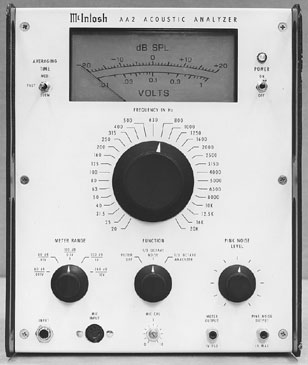 Management decides not to use this but, instead,
creates a McIntosh product. It is the beginning of the McIntosh AA2 analyzer.
The first prototype (shown in black & white) has a light gray panel and a
blue meter. Later, the panel is changed to black and the meter is white.
Management decides not to use this but, instead,
creates a McIntosh product. It is the beginning of the McIntosh AA2 analyzer.
The first prototype (shown in black & white) has a light gray panel and a
blue meter. Later, the panel is changed to black and the meter is white.
The meter averaging time switch is located at the upper left. Originally, There are 3 averaging times: slow, medium and fast. The switch is changed to slow or fast when the AA2 goes into production. The power switch is at the upper right and above it is a red LED power indicator. The upper meter scale is linear in dB and has a range of –20dB to +20dB. The scale at the bottom is in volts.
The main frequency switch selects each standard 1/3 octave class III filter from 20Hz to 20kHz. Below this switch to the left is the 5-position Meter Range switch in steps of 20dB and X 10 volts. The range is from 40dB (.001V) to 140dB (10V). This was changed for production to be switched in steps of 10dB. The range is then 60dB (.001V) to 100dB (.1V)
In the center is the 3-position Function switch having positions of Filter Off, 1/3 Octave Noise or 1/3 Octave Analyzer. At the right is the Pink Noise Level control.
At the bottom left is the Input for line level, Microphone Input, Microphone Calibrate, Meter Output (1V at full scale deflection), and the Pink Noise Output (1V maximum).
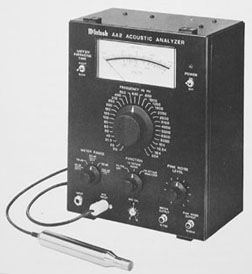 The prototype has no cover. In production, a deep
metal cover holds the microphone and 10 foot cord. The cover is held in place
with four plastic snap latches.
The prototype has no cover. In production, a deep
metal cover holds the microphone and 10 foot cord. The cover is held in place
with four plastic snap latches.
Due to the high peak capability of random noise sources, a limiter is used to eliminate peaks that could otherwise overdrive equipment in the system under test. This limiter in no way affects the measurements. Pink noise is filtered white noise. White noise has constant energy per cycle and has the same spectrum as FM interstation hiss before the de-emphasis network in an FM tuner. By passing the white noise through a filter of minus 3dB per octave, pink noise is created. This has constant energy per octave and correlates much better with musical energy as well as how we hear.
Because a constant percent bandwidth is a characteristic of 1/3 octave filters, the actual bandwidth increases with frequency. For accurate meter readings, the product of the bandwidth and the averaging time must be constant. The low frequencies therefore must have a longer averaging time. The slow switch position is used for frequencies from 20 to 160Hz. A short averaging time can be used for frequencies from 200 to 20kHz.
An AA2 Owner’s Manual can be found on a separate page.
Specifications
Meter circuit
Meter range: 20Hz to 20kHz, response +0.5dB
Waveform Response: Average responding calibrated in RMS volts and dB
SPL
Averaging Time: Selectable, fast and slow (5 sec and 30 sec)
Signal Range: SPL, 60 dB to 100 dB at mid scale, 1 mV to 100 mV
volts, AC full scale
Meter Scales: volts, calibrated from .01 to .1, SPL, calibrated
from –20dB to + 20dB
Crest factor: greater than 4 at full scale
Input impedance: 50k ohms and less than 50pf
One Third octave Filter
Frequency Range: 20Hz to 20kHz in 31 ranges with ISO recommended band
frequencies (20, 25, 31.5, 40, 50, 63, 80, 100, 125, 160, 200 and multiples of
10 thereof)
Selectivity: 1/3 octave bandwidth (29% wide). Two filter sections
arew used each having a 2 pole Butterworth filter characteristic. At .58 and
1.8 times the center frequency, each section is down 15dB (30dB for both
sections)
Pink Noise Generator
Frequancy Range: 20 to 20kHz with output in each 1/3 octave bandwidth
within +/- 1dB
Output Level: 0 to 1 volt RMS into 10k ohms or higher. Output is
peak limited for all settings of the level control.
Output Source Impedance: less than 1k ohms
Crest factor: about 4
Source: digital logic pseudo random noise generator
Power requirements
120 volts, 50-60Hz, 6 watts
Mechanical Information
Size: 11.75” high, 8.75” wide and 9.5” deep
Weight 14 lbs
Finish: black
![]()
McIntosh CM201 Condenser Microphone
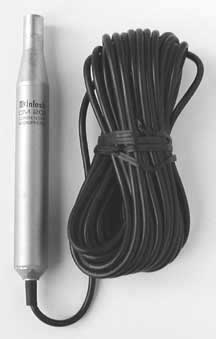 When I worked at the Sonotone Corporation, we had
dynamic microphone cartridges made by a company called Primo in Japan. I
contacted them about a high quality microphone that has very flat response down
to 20Hz and below. A typical condenser microphone will meet these requirements.
This type of microphone has a very thin and very low mass metal diaphragm. This
is stretched tightly over a circular ring. Directly behind it is a rigid plate
that is spaced about 0.001” away. The diaphragm and plate form a condenser. A
polarizing voltage of 50 to 200 volts is fed through a high value resistor to
these “plates.”
When I worked at the Sonotone Corporation, we had
dynamic microphone cartridges made by a company called Primo in Japan. I
contacted them about a high quality microphone that has very flat response down
to 20Hz and below. A typical condenser microphone will meet these requirements.
This type of microphone has a very thin and very low mass metal diaphragm. This
is stretched tightly over a circular ring. Directly behind it is a rigid plate
that is spaced about 0.001” away. The diaphragm and plate form a condenser. A
polarizing voltage of 50 to 200 volts is fed through a high value resistor to
these “plates.”
When the sound pressure moves the diaphragm closer to the plate, the charge across the condenser increases and there is an analogous increase in voltage. When it moves away, the charge decreases and the voltage decreases. This changing voltage can then be amplified.
An electret microphone is a slightly different type of condenser microphone that has a diaphragm made of a charged plastic material tightly stretched over a circular ring. The charge is permanent. The advantage of the electret cartridge is that it needs no polarizing voltage between the diaphragm and the rigid back plate. The charged plastic diaphragm will produce voltage changes between itself and the closely spaced plate behind it as sound strikes the diaphragm. A microphone of this type is less expensive. However it is more susceptible to damage from the environment and cannot be restored. If the diaphragm stretches for any reason, that’s the end of it.
Either type of microphone is electrically nothing more than a very small capacitor. It is not practical to run shielded cables from the cartridge to the analyzer. The cable capacity is much higher and forms a voltage divider making the electrical circuit look like two capacitors in series. The resulting output voltage is so low that amplifier noise then becomes a serious problem.
 For these types of microphone, a preamplifier
(impedance converter) is normally built onto the microphone handle directly
behind the cartridge. It converts the high impedance of the condenser element
to low impedance so that long cables can be run to the remaining equipment. The
Electret microphone can be operated using only a small battery in the handle
for the preamp. However, the metal diaphragm condenser microphone often has an
external power supply. It supplies two voltages; one for the polarizing voltage
and one for the preamplifier. The gain of the preamplifier is usually slightly
less than unity. The CM201 uses an FET source follower to provide the very high
input impedance that is required.
For these types of microphone, a preamplifier
(impedance converter) is normally built onto the microphone handle directly
behind the cartridge. It converts the high impedance of the condenser element
to low impedance so that long cables can be run to the remaining equipment. The
Electret microphone can be operated using only a small battery in the handle
for the preamp. However, the metal diaphragm condenser microphone often has an
external power supply. It supplies two voltages; one for the polarizing voltage
and one for the preamplifier. The gain of the preamplifier is usually slightly
less than unity. The CM201 uses an FET source follower to provide the very high
input impedance that is required.
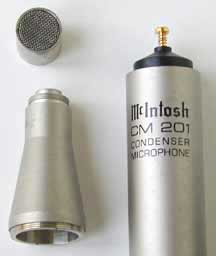 A metal diaphragm cartridge is selected for
reliability and ruggedness. An omnidirectional response is required.
Directional condenser microphones utilize rear venting that affects the
smoothness of response at the low frequencies and is undesirable as an
instrumentation microphone. A smaller diameter microphone has lower moving mass
and goes out to a higher frequency. The MC201 cartridge outside diameter is ˝”.
A negligible surface around the microphone is essential to avoid pressure
buildup at the diaphragm that can affect the response at high frequencies. The
main part of the handle must have a larger diameter to accommodate the preamp
printed circuit board. A tapered section is used in between the ˝” microphone
cartridge and the 13/16” diameter” handle to eliminate pressure buildup.
A metal diaphragm cartridge is selected for
reliability and ruggedness. An omnidirectional response is required.
Directional condenser microphones utilize rear venting that affects the
smoothness of response at the low frequencies and is undesirable as an
instrumentation microphone. A smaller diameter microphone has lower moving mass
and goes out to a higher frequency. The MC201 cartridge outside diameter is ˝”.
A negligible surface around the microphone is essential to avoid pressure
buildup at the diaphragm that can affect the response at high frequencies. The
main part of the handle must have a larger diameter to accommodate the preamp
printed circuit board. A tapered section is used in between the ˝” microphone
cartridge and the 13/16” diameter” handle to eliminate pressure buildup.
A long pin is used in the center of the tapered section to electrically connect the main handle and the microphone cartridge. The connection in the main handle is spring-loaded and pushes the pin against the contact in the microphone cartridge. This allows the sections to be unscrewed without having a wire that can twist and break. All of the contacts are gold plated so that good electrical contact is assured.
Diaphragm resonance is kept very high and internal cartridge acoustic resistance damping helps to keep the Q reasonably low. Typically it has a peak of about 3dB at 15kHz at zero degrees incidence. An individual calibration curve is supplied with each microphone. Because each microphone cartridge has a slightly different sensitivity, a calibration control in the McIntosh AA2 analyzer is factory set to compensate for each cartridge. A ten foot shielded cable is supplied with the microphone. It supplies the voltages and is shielded for the microphone output. This same microphone design was later used by Nakamichi for their tape recorders.
In the AA2 manual, two different kinds of response characteristics are shown. Typical free field response curves are provided at 0, 30, 60 and 90 degrees incidence. In addition, a random incidence response is provided. It shows that the random incidence response is the same as the free field response below 3000Hz.
Specifications
Response: 20 t0 20,000Hz
Sensitivity: 65dB re 1 volt per microbar at 1kHz nominal
Noise Equivalent: 44dB SPL unweighted
Cartridge Diameter: 0.46” (13mm)
Cable: two conductor shielded. Lemgth 10 meters (32.8 feet)
Stand Adapter: with 5/8-27 thread
![]()
Typical practice for random noise testing of loudspeakers involves feeding broadband pink noise through an amplifier system to the speaker. This is normally done one channel at a time. The microphone picks up the sound and is fed to 1/3 octave filters and the output of each band is then read on the meter. The readings can be marked down on a pad of chart paper that is supplied with the AA2 analyzer.
Gordon Gow found that making measurements in a customer's home with broadband pink noise could be very loud and disturbing, even at a 1 or 2 watt level. The initial AA2 design was modified to include an added capability of narrow band noise measurement. In the 1/3 octave switch position, one frequency selectable 1/3 octave filter is switched to the pink noise output. This provides 1/3-octave bands of pink noise to drive the speaker. A second 1/3-octave filter is switched to the AA2 microphone input. This forms an analyzer section. The frequency control is used to select the particular frequency band of interest and is common to both pink noise output and AA2 input circuits. The two filters track each other accurately. This greatly reduces the sound level in the home. The filter at the microphone input is still needed to reduce background noise from furnaces, air conditioners, etc. that could otherwise interfere with the measurements at all frequencies.
Several hours are usually spent in a customer home for the measurements. Sometimes the customer participates and helps to write down the readings for each frequency band. Gordon Gow feels the time is well spent because it sometimes results in the sale of other equipment as well. Some amount of experience is required to know how best to adjust the filters. Once a few trials are made, however, adjustments are much easier to make. In large listening areas, response at several microphone positions can be measured and averaged together.
Response correction is not used above 1kHz for two reasons. First, objectionable low frequency standing waves occur mostly below 250Hz. Secondly, equalization for a microphone position above 1kHz is very localized. At 1.13kHz, a wavelength equals one foot. Half a wavelength is 6 inches, or approximately the distance between the ears. This means that if the response is adjusted to be flat at the microphone for this frequency, only one ear can be located at the correct spot. The other ear is 1/2 wavelength away or 180 degrees out of phase. Of course, there are multiples of this frequency and for other frequencies as well. This example is somewhat simplified, but the idea is that for short wavelengths, response cannot be smoothed at higher frequencies for both ears at the same time. The solution is to start with speakers that have a smooth high frequency response and locate the tweeters and listening position several feet away from reflecting surfaces.
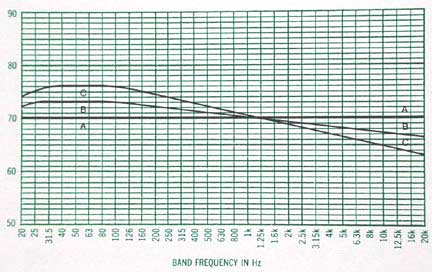 Measurement above 1kHz is mainly useful to establish a
reference for adjusting the low frequencies to complement the highs in a smooth
continuous curve. There are three suggested equalization curves depending on
listener preference. They range from classical concert hall sound (C) to
brighter rock music (B) and even to flat response (A). Flat response is
normally not preferred. For classical recordings, the microphones are often
located close to the orchestra for good signal-to-noise. However, normal high
frequency attenuation due to absorption by distance, and by surfaces including
the musicians and the audience, does not occur. Close recordings can then be
too bright and unnatural compared to the sound at a seat out in the hall. On
the other hand, for rock and new age music, there is often no reference for a
live acoustical performance without amplifiers and speakers. Flatter response
can be more favorable. Even classical music is now often performed with
electronic enhancement and the reference of an acoustical only performance is
harder to find. In the final analysis, the preference is up to the individual.
Once the response is smoothed out, tone controls can be used, perhaps more
effectively than ever before. They can be used to smoothly increase or decrease
the relative amount of highs or lows and can give an indication for listener
preference. The MQ104 cover should be reinstalled and the unit placed out of
the way.
Measurement above 1kHz is mainly useful to establish a
reference for adjusting the low frequencies to complement the highs in a smooth
continuous curve. There are three suggested equalization curves depending on
listener preference. They range from classical concert hall sound (C) to
brighter rock music (B) and even to flat response (A). Flat response is
normally not preferred. For classical recordings, the microphones are often
located close to the orchestra for good signal-to-noise. However, normal high
frequency attenuation due to absorption by distance, and by surfaces including
the musicians and the audience, does not occur. Close recordings can then be
too bright and unnatural compared to the sound at a seat out in the hall. On
the other hand, for rock and new age music, there is often no reference for a
live acoustical performance without amplifiers and speakers. Flatter response
can be more favorable. Even classical music is now often performed with
electronic enhancement and the reference of an acoustical only performance is
harder to find. In the final analysis, the preference is up to the individual.
Once the response is smoothed out, tone controls can be used, perhaps more
effectively than ever before. They can be used to smoothly increase or decrease
the relative amount of highs or lows and can give an indication for listener
preference. The MQ104 cover should be reinstalled and the unit placed out of
the way.
A few of the MQ104 equalization corrections may benefit all listening positions and speaker locations in the room. However, if location changes are made, most of the equalization must be done over again. This includes new measurements and appropriate changes to the MQ104 frequency and amplitude settings. If the speakers are moved to a new room, equalization must be done all over again.
As technology advances, real time analyzers become less expensive. Small portable analyzers like the Ivie and Audio Control make equalization much faster. These RTA's display all the bands at the same time with LED columns and class III filters.
After viewing what the room can do to the response of a system, especially at low frequencies, you can see why I decided not to put a tolerance on the advertised loudspeaker system specs. I claim response from 20-20kHz but did not claim within how many dB. Even a perfect speaker with perfectly smooth response on axis in an anechoic chamber is anything but that in the far field of any room having reflecting surfaces. Of course, if the sound isn't good because of the room, the speaker always gets the blame. If a customer complained about the sound of our speakers, we were ready with our MQ104 Custom Environmental Equalizer, AA2 analyzer and CM201 microphone.
![]()
![]()
|
About This Site |
||
|
|
More text and pictures about McIntosh will be added as my research continues. Any comments, corrections, or additions are welcome. |
|
|
|
All
contents are copyrighted |
|